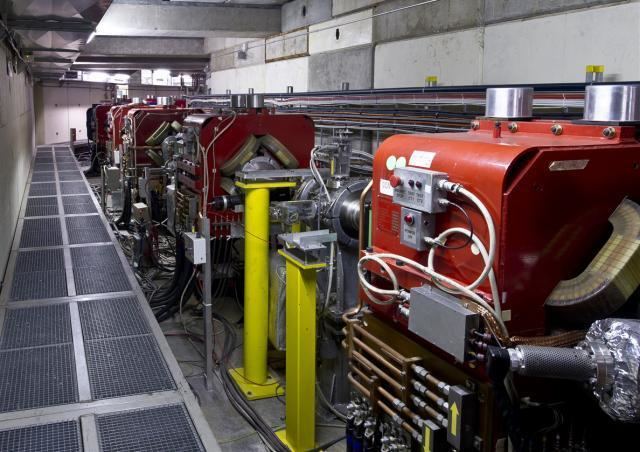 | ||
The ad antiproton decelerator
The Antiproton Decelerator (AD) is a storage ring at the CERN laboratory near Geneva. It was built as a successor to the Low Energy Antiproton Ring (LEAR) and started operation in the year 2000. Antiprotons are created by impinging a proton beam from the Proton Synchrotron on a metal target. The AD decelerates the resultant antiprotons to an energy of 5.3 MeV, which are then ejected to one of several connected experiments.
Contents
- The ad antiproton decelerator
- ELENA
- ATHENA
- ATHENA physics
- ATHENA collaboration
- ATRAP
- Positron production and accumulation
- ATRAP collaboration
- ASACUSA
- ACE
- ALPHA
- ALPHA physics
- ALPHA collaboration
- AEgIS
- AEgIS physics
- AEgIS collaboration
- GBAR
- GBAR collaboration
- BASE
- BASE collaboration
- References
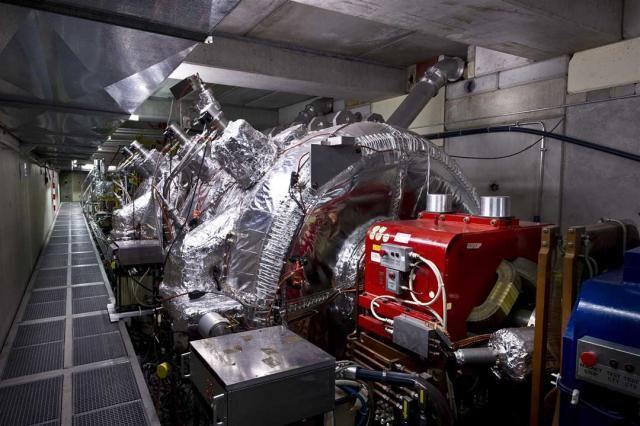
ELENA
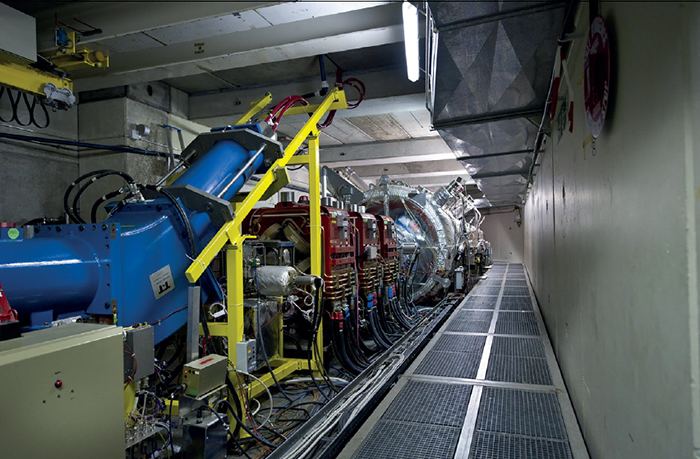
ELENA (Extra Low ENergy Antiproton) is a 30 m hexagonal storage ring situated inside the AD complex. It is designed to further decelerate the antiproton beam to an energy of 0.1 MeV for more precise measurements. The first beam circulated ELENA on the 18th November 2016. The ring is expected to be fully operational in 2017. GBAR will be the first experiment to use a beam from ELENA, with the rest of the AD experiments following suit in 2019-2020.
ATHENA
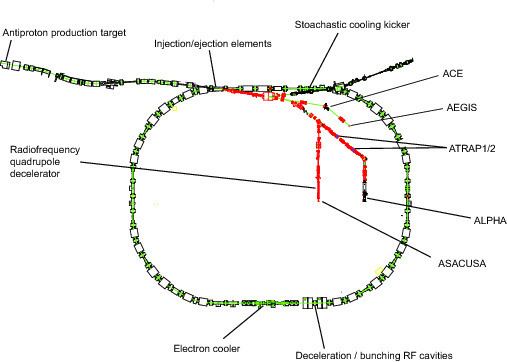
ATHENA was an antimatter research project that took place at the Antiproton Decelerator. In August 2002, it was the first experiment to produce 50,000 low-energy antihydrogen atoms, as reported in Nature. In 2005, ATHENA was disbanded and many of the former members worked on the subsequent ALPHA experiment.
ATHENA physics
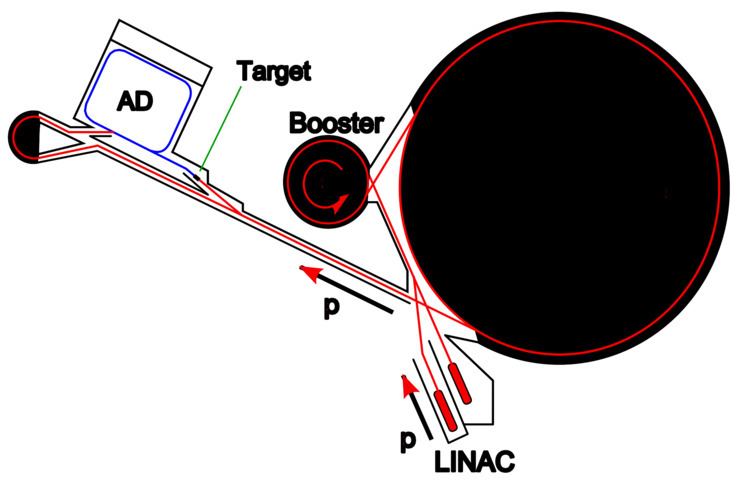
The ATHENA apparatus comprises four main subsystems: the antiproton catching trap, the positron accumulator, the antiproton/positron mixing trap, and the antihydrogen annihilation detector. All traps in the experiment are variations on the Penning trap, which uses an axial magnetic field to transversely confine the charged particles, and a series of hollow cylindrical electrodes to trap them axially (Fig. 1a). The catching and mixing traps are adjacent to each other, and coaxial with a 3 T magnetic field from a superconducting solenoid. The positron accumulator has its own magnetic system, also a solenoid, of 0.14 T. A separate cryogenic heat exchanger in the bore of the superconducting magnet cools the catching and mixing traps to about 15 K. The ATHENA apparatus features an open, modular design that allows great experimental flexibility, particularly in introducing large numbers of positrons into the apparatus.
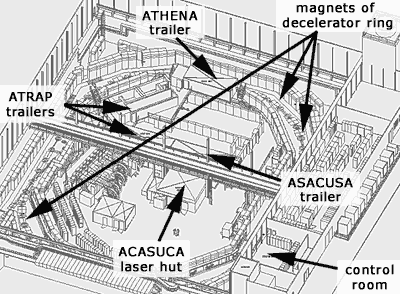
The catching trap slows, traps, cools, and accumulates antiprotons. To cool antiprotons, the catching trap is first loaded with 3x108 electrons, which cool by synchrotron radiation in the 3 T magnetic field. Typically, the AD delivers 2x107 antiprotons having kinetic energy 5.3 MeV and a pulse duration of 200 ns to the experiment at 100 s intervals. The antiprotons are slowed in a thin foil and trapped using a pulsed electric field. The antiprotons lose energy and equilibrate with the cold electrons by Coulomb interaction. The electrons are ejected before mixing the antiprotons with positrons. Each AD shot results in about 3x103 cold antiprotons for interaction experiments. The positron accumulator slows, traps and accumulates positrons emitted from a radioactive source (1.4x109 Bq Na22). Accumulation for 300 s yields 1.5x108 positrons, 50% of which are successfully transferred to the mixing trap, where they cool by synchrotron radiation.
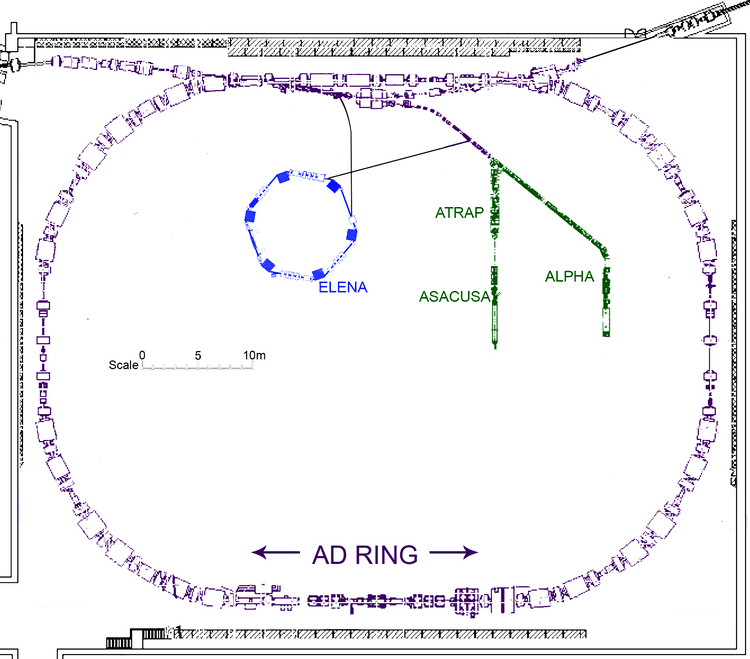
The mixing trap has the axial potential configuration of a nested Penning trap (Fig. 1b), which permits two plasmas of opposite charge to come into contact. In ATHENA, the spheroidal positron cloud can be characterized by exciting and detecting axial plasma oscillations. Typical conditions are: 7x107 stored positrons, a radius of 2 – 2.5 mm, a length of 32 mm, and a maximum density of 2.5x108 cm−3. Key to the observations reported here is the antihydrogen annihilation detector (Fig. 1a), situated coaxially with the mixing region, between the trap outer radius and the magnet bore. The detector is designed to provide unambiguous evidence for antihydrogen production by detecting the temporally and spatially coincident annihilations of the antiproton and positron when a neutral antihydrogen atom escapes the electromagnetic trap and strikes the trap electrodes. An antiproton typically annihilates into a few charged or neutral pions. The charged pions are detected by two layers of double-sided, position sensitive, silicon microstrips. The path of a charged particle passing through both layers can be reconstructed, and two or more intersecting tracks allow determination of the position, or vertex, of the antiproton annihilation. The uncertainty in vertex determination is approximately 4 mm and is dominated by the unmeasured curvature of the charged pions’ trajectories in the magnetic field. The temporal coincidence window is approximately 5 microseconds. The solid angle coverage of the interaction region is about 80% of 4π.
A positron annihilating with an electron yields two or three photons. The positron detector, comprising 16 rows each containing 12 scintillating, pure CsI crystals, is designed to detect the two-photon events, consisting of two 511 keV photons which are always emitted back-to-back. The energy resolution of the detector is 18% FWHM at 511 keV, and the photo-peak detection efficiency for single photons is about 20%. The maximum readout rate of the whole detector is about 40 Hz. Ancillary detectors include large scintillator paddles external to the magnet, and a thin, position sensitive, silicon diode through which the incident antiproton beam passes before entering the catching trap. To produce antihydrogen atoms, a positron well in the mixing region is filled with about 7x107 positrons and allowed to cool to the ambient temperature (15 K). The nested trap is then formed around the positron well. Next, approximately 104 antiprotons are launched into the mixing region by pulsing the trap from one potential configuration (dashed line, Fig. 1b) to another (solid line). The mixing time is 190 s, after which all particles are dumped and the process repeated. Events triggering the imaging silicon detector (three sides hit in the outer layer) initiate readout of both the silicon and the CsI modules.
Using this method, ATHENA could produce - for the first time - several thousands of cold antihydrogen atoms in 2002.
ATHENA collaboration
The ATHENA collaboration comprised the following institutions:
ATRAP
The ATRAP collaboration at CERN developed out of TRAP, a collaboration whose members pioneered cold antiprotons, cold positrons, and first made the ingredients of cold antihydrogen to interact. ATRAP members also pioneered accurate hydrogen spectroscopy and first observed hot antihydrogen atoms.
Positron production and accumulation
ATRAP is a collaboration between physicists around the world with the goal of creating and experimenting with antihydrogen. ATRAP accumulates positrons emitted from a radioactive 22Na source. There are two effective ways to slow down the fast positrons by inelastic processes. The ATRAP collaboration initially chose a different method to ATHENA. The positrons which were emitted by the 22Na were first slowed down with a 10 µm thick titanium foil and then passed through a 2 µm thick tungsten crystal. Within the crystal there is a possibility that a positively charged positron and a negatively charged electron form a Rydberg Positronium atom. In this process, the positrons lose much of their energy so that it is no longer necessary (as in ATHENA) to decelerate further with collisions in gas. When the loosely bound Rydberg positronium atom reaches the Penning trap at the end of the apparatus, it is ionized and the positron is caught in the trap.
Since this method of positron accumulation was not particularly efficient, ATRAP switched to a Surko-type buffer gas accumulator as is now standard in experiments requiring large numbers of positrons. This has led to the storage of the largest ever number of positrons in a Ioffe trap.
Unlike ATHENA, ATRAP has not yet been terminated and can be continuously improved and expanded. ATRAP now has a Ioffe trap, which can store the electrically neutral antihydrogen using a magnetic quadrupole field. This is possible because the magnetic moment of antihydrogen is non-zero. It is intended that laser spectroscopy will be performed on antihydrogen stored in the Ioffe trap.
ATRAP collaboration
The ATRAP collaboration comprises the following institutions:
ASACUSA
ASACUSA (Atomic Spectroscopy And Collisions Using Slow Antiprotons) is an experiment testing for CPT-symmetry by laser spectroscopy of antiprotonic helium and microwave spectroscopy of the hyperfine structure of antihydrogen. It also measures atomic and nuclear cross sections of antiprotons on various targets at extremely low energies. The spokesperson for the experiment is Ryugo S. Hayano from the University of Tokyo. It was originally proposed in 1997.
ACE
The Antiproton Cell Experiment (ACE) started in 2003. It aims to assess fully the effectiveness and suitability of antiprotons for cancer therapy.
ALPHA
The ALPHA experiment is designed to trap neutral antihydrogen in a magnetic trap, and conduct experiments on them. The ultimate goal of this endeavour is to test CPT symmetry through comparison of the atomic spectra of hydrogen and antihydrogen (see hydrogen spectral series). The ALPHA collaboration consists of some former members of the ATHENA collaboration (the first group to produce cold antihydrogen, in 2002), as well as a number of new members.
ALPHA physics
ALPHA faces several challenges. Magnetic traps – wherein neutral atoms are trapped using their magnetic moments – are notoriously weak; only atoms with kinetic energies equivalent to less than one kelvin may be trapped. The cold antihydrogen created first in 2002 by the ATHENA and the ATRAP collaborations was produced by merging cold plasmas of positrons (also called antielectrons) and antiprotons. While this method has been quite successful, it creates antiatoms with kinetic energies too large to be trapped. Furthermore, to do laser spectroscopy on these anti-atoms, it is important that they are in their ground state, something which does not seem to be the case for the majority of the anti-atoms created thus far.
Antiprotons are received by the Antiproton Decelerator and are 'mixed' with positrons from a specially-designed positron accumulator in a versatile Penning trap. The central region where the mixing and thus antihydrogen formation takes place is surrounded by a superconducting octupole magnet and two axially separated short solenoids "mirror-coils" to form a "minimum-B" magnetic trap. Once trapped antihydrogen can be subjected to detailed study and be compared to hydrogen.
In order to detect trapped antihydrogen atoms ALPHA also comprises a silicon vertex detector. This cylindrically shaped detector consists of three layers of silicon panels (strips). Each panel acts as a position sensitive detector for charged particles passing through. By recording how the panels are excited ALPHA can reconstruct the tracks of charged particles traveling through their detector. When an antiproton annihilates (disintegrates) the process typically results in the emission of 3-4 charged pions. These can be observed by the ALPHA detector and by reconstructing their tracks through the detector their origin, and thus the location of the annihilation, can be determined. These tracks are quite distinct from the tracks of cosmic rays which are also detected but are of high energy and pass straight through the detector. By carefully analyzing the tracks ALPHA distinguishes between cosmic rays and antiproton annihilations.
To detect successful trapping the ALPHA trap magnet that created the minimum B-field was designed to allow it to be quickly and repeatedly de-energized. The currents' decay during de-energization has a characteristic time of 9 ms, orders of magnitude faster than similar systems. This fast turn-off and the ability to suppress false signal from cosmic rays should allow ALPHA to detect the release of even a single trapped antihydrogen atom during de-energization of the trap.
In order to make antihydrogen cold enough to be trapped the ALPHA collaboration has implemented a novel technique, well known from atomic physics, called evaporative cooling. The motivation for this is that one of the main challenges of trapping antihydrogen is to make it cold enough. State-of-the art minimum-B traps like the one ALPHA comprises have depths in temperature units of order one Kelvin. As no readily available techniques exist to cool antihydrogen, the constituents must be cold and kept cold for the formation. Antiprotons and positrons are not easily cooled to cryogenic temperatures and the implementation of evaporative cooling is thus an important step towards antihydrogen trapping.
ALPHA collaboration
The ALPHA collaboration comprises the following institutions:
AEgIS
AEgIS (Antimatter Experiment: gravity, Interferometry, Spectroscopy), is an experiment currently being set up at the Antiproton Decelerator.
AEgIS physics
AEgIS would attempt to determine if gravity affects antimatter in the same way it affects matter by testing its effect on an antihydrogen beam. By sending a stream of antihydrogen through a series of diffraction gratings, the pattern of light and dark patterns would allegedly enable the position of the beam to be pinpointed with up to 1% accuracy. It was originally proposed in 2007.
AEgIS collaboration
The AEgIS collaboration comprises the following institutions:
GBAR
GBAR (Gravitational Behaviour of Anti hydrogen at Rest), is a multinational collaboration at the Antiproton Decelerator (AD) of CERN.
The GBAR project, aims to measure the free fall acceleration of ultracold neutral anti hydrogen atoms in the terrestrial gravitational field. The experiment consists preparing anti hydrogen ions (one antiproton and two positrons) and sympathetically cooling them with Be + ions to less than 10 μK. The ultracold ions will then be photoionized just above threshold, and the free fall time over a known distance measured.
GBAR collaboration
The GBAR collaboration comprises the following institutions:
BASE
BASE (Baryon Antibaryon Symmetry Experiment), is a multinational collaboration at the Antiproton Decelerator (AD) of CERN.
The goal of the Japanese/German BASE collaboration are high-precision investigations of the fundamental properties of the antiproton, namely the charge-to-mass ratio and the magnetic moment. To this end single antiprotons are stored in an advanced Penning trap system, which has a double-trap system at its core. It consists of a precision trap and an analysis trap. The precision trap is for high precision frequency measurements, the analysis trap has a strong magnetic field inhomogeneity superimposed, which is used for single particle spin flip spectroscopy. By measuring the spin flip rate as a function of the frequency of an externally applied magnetic-drive, a resonance curve is obtained. Together with a measurement of the cyclotron frequency, the magnetic moment is extracted.
The BASE collaboration developed techniques to observe the first spin flips of a single trapped proton and applied the double-trap technique to measure the magnetic moment of the proton with a fractional precision of three parts in a billion, being the most precise measurement of this fundamental property of the proton. The application of the technique to measure the magnetic moment of the antiproton with similar precision will improve the precision of this value by at least a factor of 1000, and will provide one of the most stringent tests of CPT invariance to date.
BASE collaboration
The BASE collaboration comprises the following institutions:
